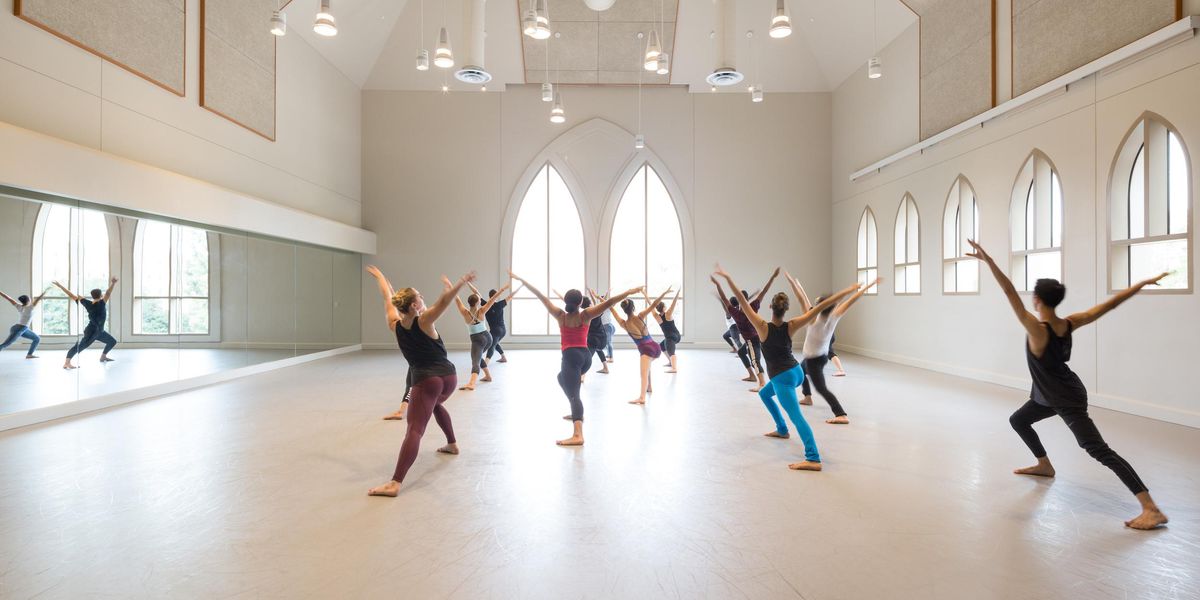The Road to Residency
GMU dancers perform Stephen Petronio’s
Lareigne during a residency. Photo by Evan Cantwell, Courtesy GMU.
Choreographer Monica Bill Barnes has been an artist in residence at more than 10 universities over the last decade. These gigs have given her the chance to hone her teaching skills and develop and present her work. “I feel so lucky my residencies have always gone well,” she says. “I choreograph not because I know how but because I’m trying to figure it out, quite actively, and to invite people into that conversation.”
College residencies can be a boon to working artists. Funding! Dancers! Space! Audiences! Institutional validation! And artists in turn benefit college dance programs through performing, teaching and perhaps even hiring students they have worked with. There’s rarely an application process, but there are a few steps you can take to work your way toward coveted artist-in-residence status.
Starting the Conversation
Getting considered for a residency starts with researching what college programs might be a fit for you and your work. Sending out press kits (whether in print or by e-mail) to a wide swath of possible presenters is unlikely to get you anywhere. A college administrator is usually overtasked and may not have time to review them, especially if it seems like they were mailed out en masse.
Learn as much as you can about university programs before approaching them—research the aesthetic of institutions that interest you, says Susan Shields, director of dance at George Mason University. Then show the director you’ve done your homework through an e-mail, phone call or letter describing your work and how you think it fits with their program. “What’s helpful is when someone can say, I’ve got this piece—click here. And this is why I think your school might be interested in it,” she says.
Networking is key. Try watching a college company perform at a festival and approaching a faculty member afterward with your card and a reflection on what you saw and why it interested you. Barnes notes that when performing on tour, she used to reach out to nearby universities (if they had dance programs) and offer to teach a master class, sometimes even for free. Faculty who have seen you teach will remember your name when opportunities arise at their institution.
What to Offer
When you approach a director, be clear and articulate about your aesthetic, teaching interests and experience. What parts of the curriculum intrigue you and why? And how might you fit in? Can you teach modern classes? Composition or choreography? Does your work emphasize community engagement? Are you interested in advising or mentoring students? The answers to these questions should be apparent on your resumé or website, or in your conversations with faculty or directors. Some schools may want you to teach, set work or perform; others might be interested in offering lecture demonstrations or master classes in their community. Be clear about what you will and will not be available to do, and how much is included in your artist fee.
In general, your offerings should reflect an interest in college dance. “You have to have a love of students, and no snobbery toward dance in higher education,” says Shields.
Keys to Successful—and Future—Residencies
Once you’ve made it in the door, do your work well and make good on what you offered. “The only thing that has ever gotten me the next job was, whatever job I had, doing it really well,” says Barnes. “I’ve always tried to represent myself accurately. So that when I came somewhere, they didn’t feel disappointed that I didn’t teach Cunningham. It is a small network and people know what they want. And everybody is honest about it. There’s an integrity to the way the system works.”
The Timeline
Timing is critical. Sending out queries in May looking for work that fall is unlikely to yield fruit, beyond maybe a master class or two. For a substantial residency or presenting engagement, most universities work at least one year in advance, and often more if they rely on outside funding for presenting projects. You should also take note of the academic calendar, which will govern the structure and timeline of residencies for any university. Know when the fall and spring semesters begin and end, and when the mid-semester breaks are (usually a couple of days in October and a week in March).
Money Talks
How much should you charge? Ask around to get a sense of the fees other artists ask for. University budgets are tight, and you want to make sure your fee is reasonable. A single master class might vary between $75 and $300. For a teaching residency, anywhere from $1,500 to $3,000 per week (excluding travel and lodging) may be suitable, depending on the number of classes taught and what stage you are at in your career. These numbers might be higher if you are setting a work.




